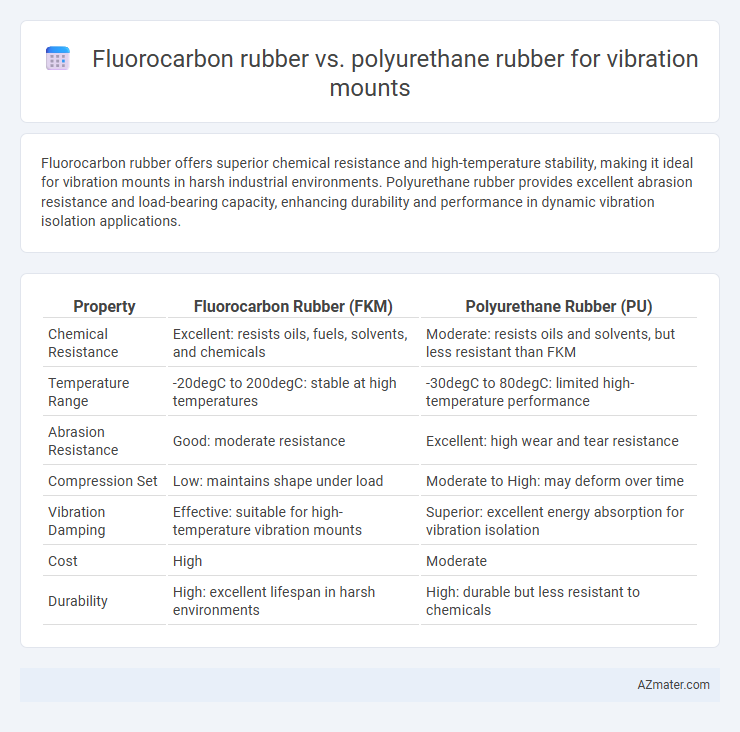Fluorocarbon rubber offers superior chemical resistance and high-temperature stability, making it ideal for vibration mounts in harsh industrial environments. Polyurethane rubber provides excellent abrasion resistance and load-bearing capacity, enhancing durability and performance in dynamic vibration isolation applications.
Table of Comparison
| Property | Fluorocarbon Rubber (FKM) | Polyurethane Rubber (PU) |
|---|---|---|
| Chemical Resistance | Excellent: resists oils, fuels, solvents, and chemicals | Moderate: resists oils and solvents, but less resistant than FKM |
| Temperature Range | -20degC to 200degC: stable at high temperatures | -30degC to 80degC: limited high-temperature performance |
| Abrasion Resistance | Good: moderate resistance | Excellent: high wear and tear resistance |
| Compression Set | Low: maintains shape under load | Moderate to High: may deform over time |
| Vibration Damping | Effective: suitable for high-temperature vibration mounts | Superior: excellent energy absorption for vibration isolation |
| Cost | High | Moderate |
| Durability | High: excellent lifespan in harsh environments | High: durable but less resistant to chemicals |
Introduction to Fluorocarbon and Polyurethane Rubber
Fluorocarbon rubber, known for its exceptional chemical resistance and high-temperature stability, is ideal for vibration mounts in harsh environments where exposure to oils, fuels, and solvents is common. Polyurethane rubber offers superior abrasion resistance and excellent load-bearing capacity, making it suitable for applications requiring durability and flexibility under repetitive stress. Both materials provide unique advantages in vibration damping, with fluorocarbon excelling in chemical durability and polyurethane in mechanical resilience.
Chemical Structure Differences
Fluorocarbon rubber (FKM) features a carbon-fluorine bond backbone resulting in exceptional chemical resistance and thermal stability, making it suitable for harsh environments. Polyurethane rubber (PU) contains urethane linkages formed by the reaction of isocyanates and polyols, providing superior mechanical strength and wear resistance but lower chemical resilience compared to FKM. The inherent differences in their polymer chains influence vibration dampening capabilities and compatibility with various chemicals for vibration mount applications.
Temperature Resistance Comparison
Fluorocarbon rubber exhibits superior temperature resistance, operating effectively within a range of -20degC to 200degC, making it ideal for vibration mounts in high-heat environments. Polyurethane rubber typically withstands temperatures from -40degC to 80degC, which limits its use in applications exposed to prolonged high temperatures. The enhanced thermal stability of fluorocarbon rubber ensures durability and performance retention in industrial settings with extreme thermal demands.
Oil and Chemical Compatibility
Fluorocarbon rubber exhibits superior oil and chemical resistance compared to polyurethane rubber, making it ideal for vibration mounts exposed to harsh oils, fuels, and aggressive chemicals. Polyurethane rubber offers good abrasion resistance but tends to degrade faster when in contact with mineral oils, solvents, and strong chemicals. Selecting fluorocarbon rubber for vibration mounts ensures enhanced durability and prolonged performance in chemically aggressive environments.
Mechanical Strength and Durability
Fluorocarbon rubber exhibits superior chemical resistance and thermal stability, making it ideal for vibration mounts in harsh environments requiring high mechanical strength and long-term durability. Polyurethane rubber offers excellent abrasion resistance and tensile strength but may degrade faster under extreme temperatures and aggressive chemicals compared to fluorocarbon variants. Selecting fluorocarbon rubber ensures enhanced lifespan and reliable performance where mechanical stress and environmental exposure are critical factors.
Abrasion and Wear Resistance
Fluorocarbon rubber offers exceptional abrasion and wear resistance due to its high chemical stability and strong molecular bonds, making it ideal for harsh environments with exposure to oils and solvents. Polyurethane rubber provides superior mechanical strength and excellent resistance to tearing and cutting, which enhances durability under repetitive stress and abrasive conditions. For vibration mounts, fluorocarbon rubber excels in chemical-resistant abrasion, whereas polyurethane rubber is preferred for high-impact, wear-intensive applications.
Vibration Damping Performance
Fluorocarbon rubber offers superior chemical resistance and moderate vibration damping, making it ideal for applications exposed to harsh environments but requiring moderate vibration isolation. Polyurethane rubber provides excellent vibration damping performance with higher resilience and energy absorption, effectively reducing shock and vibration transmission in dynamic loads. For vibration mounts, polyurethane rubber generally outperforms fluorocarbon rubber in damping efficiency, especially in applications demanding high durability and noise reduction.
Environmental Suitability and Longevity
Fluorocarbon rubber offers superior chemical and heat resistance, making it highly suitable for vibration mounts in harsh environmental conditions with exposure to oils, fuels, and extreme temperatures. Polyurethane rubber provides excellent abrasion resistance and toughness, delivering extended longevity in applications subject to mechanical wear and dynamic stress. Selecting fluorocarbon rubber enhances environmental durability, while polyurethane rubber optimizes lifespan through mechanical resilience in vibration isolation systems.
Cost Analysis and Economic Considerations
Fluorocarbon rubber offers superior chemical and temperature resistance ideal for high-performance vibration mounts but comes with higher material and manufacturing costs compared to polyurethane rubber. Polyurethane rubber provides a cost-effective solution with good abrasion resistance and durability, making it suitable for applications with moderate environmental demands. Evaluating total lifecycle costs, polyurethane often yields better economic value in budget-sensitive projects, while fluorocarbon rubber is preferred for critical applications demanding long-term reliability despite its premium price.
Application Recommendations for Vibration Mounts
Fluorocarbon rubber offers superior chemical resistance and heat stability, making it ideal for vibration mounts used in harsh industrial environments, such as automotive exhaust systems and chemical processing equipment. Polyurethane rubber provides excellent abrasion resistance and load-bearing capacity, making it well-suited for vibration mounts in heavy machinery and construction equipment where durability and shock absorption are critical. Selection between fluorocarbon and polyurethane rubber for vibration mounts should be based on specific application demands including exposure to chemicals, temperature range, and mechanical stress conditions.

Infographic: Fluorocarbon rubber vs Polyurethane rubber for Vibration mount
 azmater.com
azmater.com